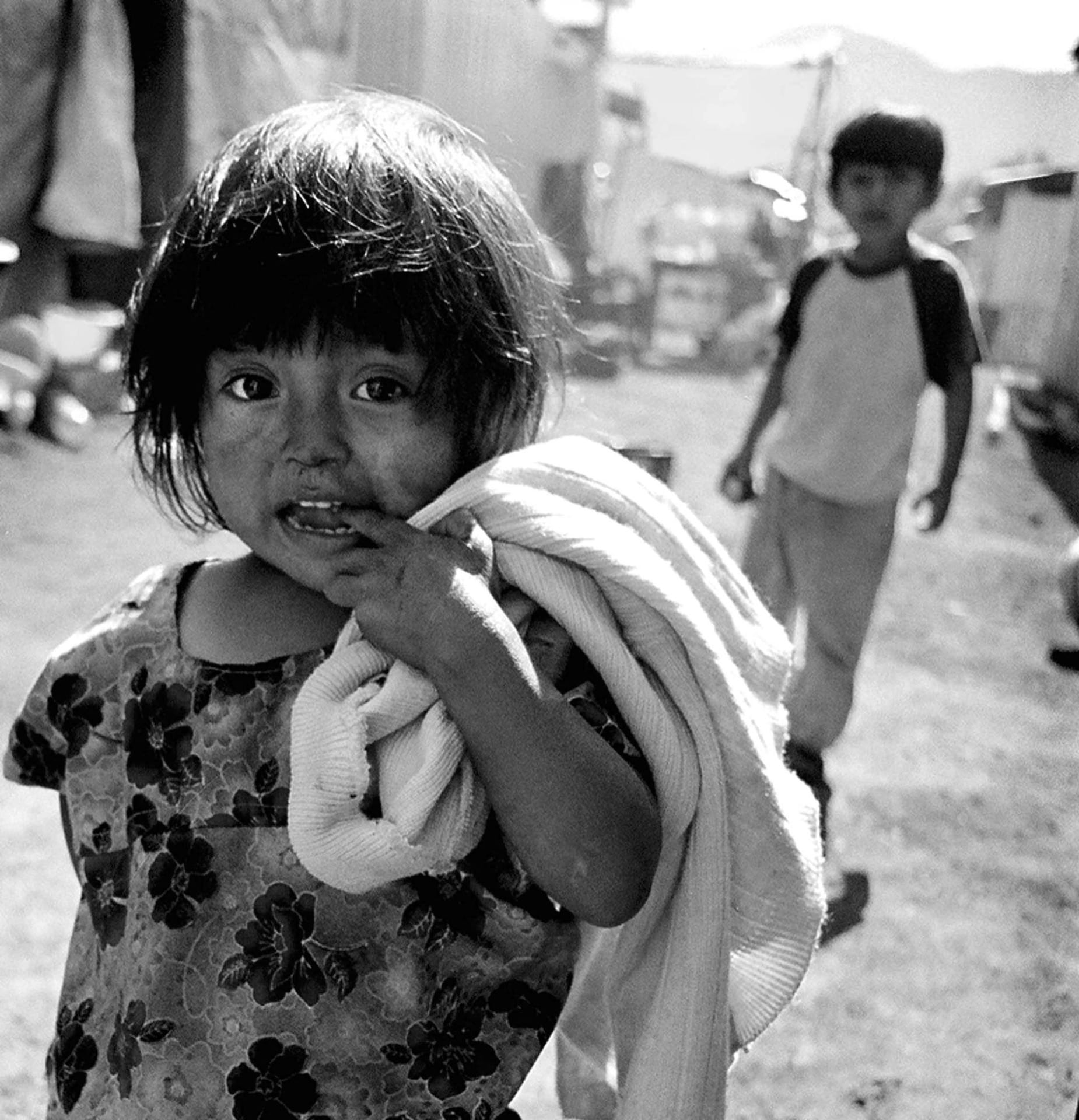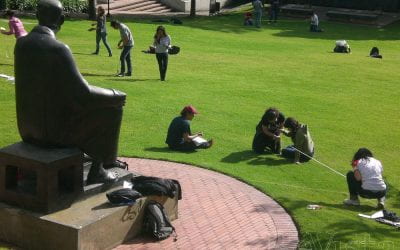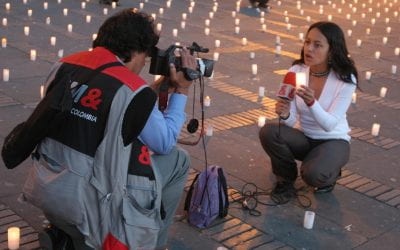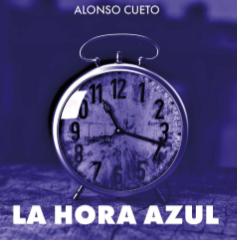The Symbolic as Strategy
After the Violence
It is now more than a decade since Peru suffered devastating political violence, which left about 70,000 dead. Years have passed since the Report of the Commission of Truth and Reconciliation (CVR in Spanish) documented the atrocities. The CVR conducted field research with testimonies from 17,000 victims led the report to categorically denounce the massive perpetration of crimes, in many cases coordinated or planned by the organizations or institutions taking part directly in the 20-year conflict between the Peruvian state and Shining Path guerrillas. Its pages describe the annihilation of communities and the devastation of certain villages by both the state and Shining Path, which each invoked “strategic reasons” for their death sentences for thousands of Peruvian citizens.
Today, political parties claim that the events described in the report never took place, reject its conclusions, and refuse to engage in significant self-criticism. For their part, popular organizations and social movements, already extremely limited in their scope, have decided to go off in different directions and engage in other struggles; civil society as a whole asserts that the “past is past,” and that it’s best not to dwell on Peru’s violent legacy.
Where are the reparations; where is the memory; where is the effort to prevent terror from repeating itself? If we look at the national scene, we’ll find that the CVR has had a profound impact on culture, much more so than on any other social sphere. The conclusions of the report are beginning to permeate the Peruvian imaginary (and hopefully its institutional practices) through art, music and theater, rather than through the political realm. Cultural texts provide a vehicle of public understanding. That is, in a generalized situation of resistance to the CVR’s conclusions and information, with an accompanying national incapacity to deal with trauma and truth, Peruvian artists have made an effort to represent the legacies of violence and to insist that the public engage in a debate about Peru’s tormented past.
For many of these artists, the past is an “internal” dimension that is far from being finished or resolved. They do not adopt a defensive attitude; rather, their present strategy consists of symbolizing what happened in order to attempt to construct a new narrative for the country. Artists, in their different creations, try to represent a series of demands for justice and equality in the context of the dispute about how to reorganize the past and to construct a new present.
Cultural texts provide many examples and many different genres: literature (short stories, song lyrics, novels), visual art (photo and art exhibits, handicrafts), music (from traditional to rock), film and a multitude of other cultural manifestations. The Peruvian novel, in particular, drew international attention in 2006. Alonso Cueto’s La Hora Azul and Santiago Roncagliolo’s Abril Rojo won the two most prestigious literary awards in the Spanish-speaking world (Anagrama and Alfaguara). The two novels placed the theme of the legacy of political violence upon the international literary scene, structuring their plots on the CVR report’s conclusions and trying to open spaces so that Peru’s invisible wounds can finally be seen.
My point is that Peruvian art in its various genres and forms plays a crucial role in facilitating the CVR report’s entry into the national culture. Through the mediation of art, the report begins to have some effect in the construction of new political practices. While we can indeed assert that the report was a failure in the political sphere, many of its conclusions are now “percolating” in the Peruvian society through artistic representations—in different media and with different strategies—that bring the report to the public attention and integrate its contents into the public perception.
Unfortunately, the CVR discovered all too late the enormous potential of symbolic resources. I won’t dwell on the serious errors in communications strategy, but rather on the international success of the famous photo exhibition Yunayapaq that depicts the abuses described in the report. This exhibit is a prime example that recognizes the importance of the symbolic as a central venue in political struggle.
In his book The Plague of Fantasies, Slovene literary critic Slavoj Zizek explains: “If real death is not accompanied by symbolic death, that is, if there is not a true accounting, the ghosts of the dead will come back permanently as a terrible apparition until the debt has been paid” (181). I believe that the symbolic is fulfilling a fundamental role in Peruvian public life, and that the artistic space is being used as a resource capable of expanding our notions of citizenship and of attaining a certain symbolic resolution. In a way, the CVR report can be understood as a project that gives a “second death” to the dead of this country. It seems to me therefore that there are now two basic tasks going forth.
The first is to show; it is clear that the political discourse has failed to do so, while culture appears to be a much more suitable agent to intervene on the side of common sense and to begin to transform perceptions. Cultural productions attempt to articulate the observed with a new discourse about reality.
The second task stems from the idea of French philosopher Jacques Derrida: “Communication begins when dialogue ends.” In general, debates are “dialogues between deaf persons” because the participants insist on maintaining their positions. Each side takes a firm stance and neither is willing to bend. Therefore, for Derrida, dialogue is not a place where communication occurs. The true place for communication is in the echo, in the residue and aftermath of the dialogue.
In this article, I wish to stress that culture is this echo, that symbols constitute this residue, which is destined not only to represent the reality, but also to sustain it from other perspectives, other paradigms. I conclude therefore that the symbolic is a weapon for political struggle, and that we can work much more on this aspect of communicating political truths through culture. The CVR report is now a “discursive resource,” and, in that sense, it has not failed; it simply has entered the country in a different manner, perhaps clandestinely. Put in another fashion, in the face of the perverse negation of history by the current government in Peru, I believe that cultural texts are becoming much more seductive mechanisms for obtaining significant social spaces and recognizing the struggles memory faces—with patience—in contemporary Peru.
Winter 2008, Volume VII, Number 2
Víctor Vich teaches Latin American literature at the Pontificia Universidad Católica of Perú and is principal researcher at the Instituto de Estudios Peruanos (IEP). He was the 2007-08 Santo Domingo Visiting Scholar at the David Rockefeller Center for Latin American Studies. His publications include El discurso de la calle: los cómicos ambulantes y las tensiones de la modernidad en el Peru (2001) and El caníbal es el otro. Violencia y cultura en el Perú contemporáneo (Lima, 2003).
Related Articles
Maintaining Academic Excellence in Latin American Universities
The Iniciativa para el Desarrollo de la Innovación Académica (IDIA), a teaching and learning initiative of LASPAU, helps higher education institutions in Latin America address the perennial…
Sobre Envíos Epistolares y Violencias
A través del proyecto “Cartas de la Persistencia”, liderado por la Biblioteca Luis Angel Arango del Banco de la República, la Secretaría Distrital de Cultura y Turismo de Bogotá y el Instituto Pensar…
Novelas
La hora azul de Alonso Cueto es la historia de Adrián Ormache, un destacado abogado limeño que, luego de la muerte de su madre, comienza a descubrir una pasado familiar ciertamente…





